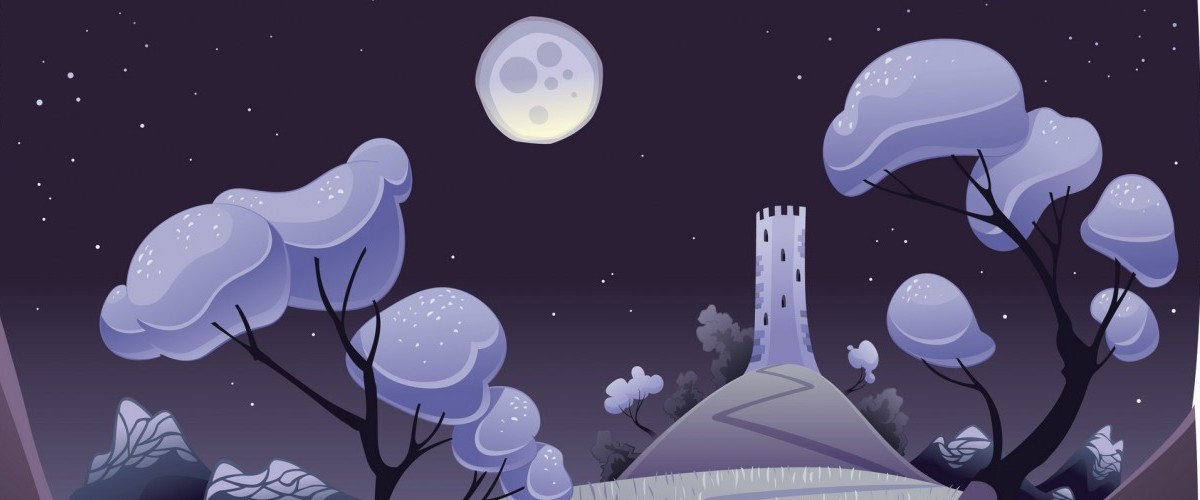
Blue Room: The Brothers Grimm
This month students will be introduced to the famous brothers who brought to the world some of our most beloved tales, the Grimm Brothers. The Grimm Brothers and some of their most famous stories will be the focus for the month. Come and explore the four tales we will be reading this month and see how much we will be learning through the careful examination of these stories!
Week 1: Rumpelstiltskin
 The Grimm Brothers, who authored many fairy tales, will be the focus of lessons throughout the month. While the Grimms may not have necessarily come up with the idea for each and every tale they have told, they are responsible for the tales as we now know them. The Grimm Brothers were avid collectors of folk tales. They took stories they had heard in their travels and transcribed them so that the world would have the opportunity to experience some of these magical and sometimes dark tales. Week 1 in the Blue Room is focused on one of the Grimm Brothers most famous fairy tales ever told, the story of Rumpelstiltskin. Rumpelstiltskin is the story of a miller’s daughter whom the king believes can spin straw into gold. The king brings the miller’s daughter to his castle and asks her to spin straw into gold. She receives help from a strange little man and agrees to give him her first born child in exchange for his help. After becoming queen and giving birth to her first child, the strange little man returns to collect what is owed him. The only way the queen can save her child from its fate is to guess the name of the strange little man. The queen, after several wrong guesses, finally discovers the name of the strange little man causing him to disappear never to be heard from again.
The Grimm Brothers, who authored many fairy tales, will be the focus of lessons throughout the month. While the Grimms may not have necessarily come up with the idea for each and every tale they have told, they are responsible for the tales as we now know them. The Grimm Brothers were avid collectors of folk tales. They took stories they had heard in their travels and transcribed them so that the world would have the opportunity to experience some of these magical and sometimes dark tales. Week 1 in the Blue Room is focused on one of the Grimm Brothers most famous fairy tales ever told, the story of Rumpelstiltskin. Rumpelstiltskin is the story of a miller’s daughter whom the king believes can spin straw into gold. The king brings the miller’s daughter to his castle and asks her to spin straw into gold. She receives help from a strange little man and agrees to give him her first born child in exchange for his help. After becoming queen and giving birth to her first child, the strange little man returns to collect what is owed him. The only way the queen can save her child from its fate is to guess the name of the strange little man. The queen, after several wrong guesses, finally discovers the name of the strange little man causing him to disappear never to be heard from again.
Week 1 Sub Theme Objectives:
1. Be introduced to the Grimm Brothers and know why their stories have become so famous.
2. Be familiar with the story Rumplestilskin including the characters and events of the story as well as where the story originated.
3. Become familiar with the words miller, spinning wheel, spool and gleaming so as to better understand the text when read.
Week 2: Little Red Riding Hood
 In the Blue Room will be focused on another of the Grimm Brothers famous tales, Little Red Riding Hood. Little Red Riding Hood is the story of a little girl who encounters a wolf in the forest while on her way to bring a basket of goodies to her grandmother. The wolf manages to get to the grandmother’s house before the little girl and tries to fool the little girl by pretending to by her grandmother. Just as the wolf attempts to eat the little girl a woodsmen happens by and rescues both the little girl and her grandmother.
In the Blue Room will be focused on another of the Grimm Brothers famous tales, Little Red Riding Hood. Little Red Riding Hood is the story of a little girl who encounters a wolf in the forest while on her way to bring a basket of goodies to her grandmother. The wolf manages to get to the grandmother’s house before the little girl and tries to fool the little girl by pretending to by her grandmother. Just as the wolf attempts to eat the little girl a woodsmen happens by and rescues both the little girl and her grandmother.
Week 2 Sub Theme Objectives
1. Be starting to become more familiar with the Grimm Brothers and know why their stories have become so famous.
2. Be familiar with the story Little Red Riding Hood including the characters and events of the story as well as where the story originated.
3. Become familiar with the words bouquet, thicket, woodsmen and spectacles so as to better understand the text when read.
Week 3: Rapunzel
 Week 3 in the Blue Room will be focused on another of the Grimm Brothers classic tales, Rapunzel. The story of Rapunzel begins with a man and woman who longed to have a child. Once their dream had come true, the woman had a craving for the rapunzel that grew in the sorceress’ garden. The woman asked her husband to go and steal some of the rapunzel. The sorceress caught the man in her garden and told him that he could continue to take the rapunzel if he promised to give his child to her when it was born. The husband agreed and on the day the child was born, the sorceress came and took the child away. The sorceress raised the child into adolescence and at that time placed her into a tower to keep her away from the dangers of the world. Little did the sorceress know that a young prince would come along and fall in love with Rapunzel. The prince found a way to get into the tower and marry Rapunzel. When the sorceress found out about the prince she became enraged and sent Rapunzel away. The story ends with Rapunzel and her prince finding one another again and living happily ever after.
Week 3 in the Blue Room will be focused on another of the Grimm Brothers classic tales, Rapunzel. The story of Rapunzel begins with a man and woman who longed to have a child. Once their dream had come true, the woman had a craving for the rapunzel that grew in the sorceress’ garden. The woman asked her husband to go and steal some of the rapunzel. The sorceress caught the man in her garden and told him that he could continue to take the rapunzel if he promised to give his child to her when it was born. The husband agreed and on the day the child was born, the sorceress came and took the child away. The sorceress raised the child into adolescence and at that time placed her into a tower to keep her away from the dangers of the world. Little did the sorceress know that a young prince would come along and fall in love with Rapunzel. The prince found a way to get into the tower and marry Rapunzel. When the sorceress found out about the prince she became enraged and sent Rapunzel away. The story ends with Rapunzel and her prince finding one another again and living happily ever after.
Week 3 Sub Theme Objectives:
1. Be familiar with the Grimm Brothers and know why their stories have become so famous.
2. Be familiar with the story Rapunzel including the characters and events of the story as well as where the story originated.
3. Become familiar with the words sorceress, rapunzel (the herb in the story), tower and blind so as to better understand the text when read.
Week 4: Hansel and Gretel
 The last week of the month will again follow a similar format to that of weeks 1, 2 and 3; however, week 4 will be focused on the famous Grimm’s fairy tale of Hansel and Gretel. Hansel and Gretel, is the story of two children who are forced to leave their home by their stepmother. Once they can no longer find their way back home, they wander through the forest and happen upon a house made of sweets. While eating the house, an old woman comes out of the house pretending to be good. She brings them into her home and lets them rest in her bed. The next morning the woman puts the children in cages. She lets Gretel out to help her cook and fatten up Hansel. Hansel knows the evil woman has bad eyesight and tricks her by holding out a bone when she asks him to stick out his finger to check for plumpness. The children work together to put an end to the evil woman and find their way home.
The last week of the month will again follow a similar format to that of weeks 1, 2 and 3; however, week 4 will be focused on the famous Grimm’s fairy tale of Hansel and Gretel. Hansel and Gretel, is the story of two children who are forced to leave their home by their stepmother. Once they can no longer find their way back home, they wander through the forest and happen upon a house made of sweets. While eating the house, an old woman comes out of the house pretending to be good. She brings them into her home and lets them rest in her bed. The next morning the woman puts the children in cages. She lets Gretel out to help her cook and fatten up Hansel. Hansel knows the evil woman has bad eyesight and tricks her by holding out a bone when she asks him to stick out his finger to check for plumpness. The children work together to put an end to the evil woman and find their way home.
Week 4 Sub Theme Objectives:
1. Be familiar with the Grimm Brothers and know why their stories have become so famous.
2. Be familiar with the story Hansel and Gretel including the characters and events of the story as well as where the story originated.
3. Become familiar with the words pebbles, cottage, courage and abandon so as to better understand the text when read.
Learning Goals
The following learning goals will also be addressed in lessons throughout the month. These learning goals are designed to introduce students to Kindergarten and First-Grade-Level concepts in developmentally and age appropriate ways. Practice some or all of these concepts at home throughout the month to further your child’s comprehension of the concept!
Speaking Applications (level k):
- Describe people, places and things, locations and actions as they relate to a story
- Relate a story in a logical sequence
Reading Comprehension (level k):
- Use pictures and context to make predictions about story content
Writing (level k):
- Write upper and lowercase letters of the alphabet independently attending to the form and proper spacing of the letters
Letters:
Recognition, Sounds and Writing
The learning of letters is worked into each and every lesson that students participate in in the Blue Room. Teachers plan “Alphabet Opportunities” so that students have ample time to practice letter recognition, phonics and letter writing throughout the month.
Green Room: Bizarre Nature
This month students will have the opportunity to explore nature in its most bizarre form! The creepiest and crawliest of nature will be sure to get all students in the Halloween spirit!
Week 1: Carnivorous Plants
 Week 1 in the Green Room will be focused on learning about carnivorous plants. The week’s lessons will be centered around four distinct types of carnivorous plants: the Venus flytrap, Bladderwort, Pitcher plant and Sundew. The book, Hungry Plants by Mary Batten, will be used to introduce students to the idea of carnivorous plants as well as each new individual carnivorous plant throughout the week. The books, "Plants Bite Back" by Richard Platt and "Plants that Eat Animals" by Allan Fowler, will also be resources used throughout the week.
Week 1 in the Green Room will be focused on learning about carnivorous plants. The week’s lessons will be centered around four distinct types of carnivorous plants: the Venus flytrap, Bladderwort, Pitcher plant and Sundew. The book, Hungry Plants by Mary Batten, will be used to introduce students to the idea of carnivorous plants as well as each new individual carnivorous plant throughout the week. The books, "Plants Bite Back" by Richard Platt and "Plants that Eat Animals" by Allan Fowler, will also be resources used throughout the week.
Week 1 Sub Theme Objectives:
1. Be familiar with the term carnivorous plant.
2. Be familiar with four types of carnivorous plants (the Venus flytrap, the Bladderwort, the Pitcher plant and Sundews) and the types of insects each consume.
3. Understand that carnivorous plants can not harm humans.
Week 2: Bioluminescence
 Week 2 in the Green Room will focus on introducing students to the phenomenon of bioluminescence through the use of the book, "The Winking, Blinking Sea" by Mary Batten.
Week 2 in the Green Room will focus on introducing students to the phenomenon of bioluminescence through the use of the book, "The Winking, Blinking Sea" by Mary Batten.
Week 2 Sub Theme Objectives
1. Be familiar with the term bioluminescence.
2. Be familiar with at least two bioluminescent animals.
3. Be familiar with at least one method in how animals achieve bioluminescence.
Week 3: Shocking Species
 Week 3 in the Green Room will be focused on shocking animals and strange animal behaviors. We will be using the books, "Freak Out!" and "Gross Out!" by Ginjer Clarke to help us in our educational quest to learn more about these shockingly strange creatures!
Week 3 in the Green Room will be focused on shocking animals and strange animal behaviors. We will be using the books, "Freak Out!" and "Gross Out!" by Ginjer Clarke to help us in our educational quest to learn more about these shockingly strange creatures!
Week 3 Sub Theme Objectives:
1. Be familiar with at least one shocking species from each category (underwater, insect, reptile & amphibian, mammals & birds) and know how to accurately describe the species and its oddities.
Week 4: Decomposition
 The last week of the month will be focused on the concept of decomposition. We will start our week by reading the book "The Magic School Bus Meets the Rot Squad." This book details the process of decomposition and explains why it is so important to the life cycle. The book, "Rotters!" by John Townsend will also be used as a reference to for lessons. It has some fantastic photos that will be used to reinforce lessons that may deal with, for example, the insects that help in the decomposition process.
The last week of the month will be focused on the concept of decomposition. We will start our week by reading the book "The Magic School Bus Meets the Rot Squad." This book details the process of decomposition and explains why it is so important to the life cycle. The book, "Rotters!" by John Townsend will also be used as a reference to for lessons. It has some fantastic photos that will be used to reinforce lessons that may deal with, for example, the insects that help in the decomposition process.
Week 4 Sub Theme Objectives:
1. Be familiar with the term decomposition.
2. Be familiar with the term life cycle.
3. Understand why decomposition is so important to the life cycle.
Learning Goals
The following learning goals will also be addressed in lessons throughout the month. These learning goals are designed to introduce students to Kindergarten and First-Grade-Level -Concepts in developmentally and age appropriate ways. Practice some or all of these concepts at home throughout the month to further your child’s comprehension of the concept!
Life Science (level k):
- 1. Students know how to observe and describe similarities and differences in the appearance and behaviors of plants and animals Investigation and Experimentation: 1. Draw pictures that portray some features of the thing being described (first grade-level)
- Record observations on a bar graph (level k)
Number Sense:
- Use concrete objects to determine the answers to addition and subtraction problems for two numbers that are each less than 10
Numbers and Shapes:
- Recognition, Writing Numbers and Drawing Shapes The learning of numbers and shapes is worked into each and every lesson that students participate in in the Green Room. Teachers plan “Number and Shape Opportunities” so that students have ample time to practice number and shape recognition, number writing and shape drawing throughout the month.
Red Room: Offending the Senses
This month students will have the opportunity to explore their five senses with an exciting twist! Creepy and slimy sensory experiences will help students experience their five senses in an entirely new way… it will be a feast for the senses!
Week 1: Horrible Smells
 Week 1 will be focused on the sense of smell. The week will begin with an introduction to the sense of smell using the book, "The Five Senses: Smell" by Maria Rius. The artwork of Salvador Dali will also be worked into lessons throughout the month.
Week 1 will be focused on the sense of smell. The week will begin with an introduction to the sense of smell using the book, "The Five Senses: Smell" by Maria Rius. The artwork of Salvador Dali will also be worked into lessons throughout the month.
Week 1 Sub Theme Objectives:
1. Be introduced to the artist Salvador Dali through his art and a brief biography.
2. Be familiar with the sense of smell including knowledge of the parts of the nose that contribute to it.
3. Have participated in at least two unpleasant sensory activities involving the sense of smell.
Week 2: Excruciating Sounds
 Week 2 will be focused on the sense of hearing. The week will begin with an introduction to the sense of hearing using the book, "The Five Senses: Hearing" by Maria Rius.
Week 2 will be focused on the sense of hearing. The week will begin with an introduction to the sense of hearing using the book, "The Five Senses: Hearing" by Maria Rius.
Week 2 Sub Theme Objectives:
1. Be starting to become more familiar with the artist Salvador Dali through his art.
2. Be familiar with the sense of hearing including knowledge of the parts of the ear that contribute to it.
3. Have participated in at least two excruciating sensory activities involving the sense of sound.
Week 3: Putrid Tastes
 Week 3 will be focused on the sense of taste. The week will begin with an introduction to the sense of taste using the book, "The Five Senses: Taste" by Maria Rius.
Week 3 will be focused on the sense of taste. The week will begin with an introduction to the sense of taste using the book, "The Five Senses: Taste" by Maria Rius.
Week 3 Sub Theme Objectives:
1. Be familiar with the artist Salvador Dali.
2. Be familiar the sense of taste including knowledge of the parts of the tongue that contribute to it.
3. Have participated in at least two putrid sensory activities involving the sense of taste.
Week 4: Unpleasant Touches
 Week 4 will be focused on the sense of touch. The week will start with an introduction to the sense of touch using the book, "The Five Senses: Touch" by Maria Rius.
Week 4 will be focused on the sense of touch. The week will start with an introduction to the sense of touch using the book, "The Five Senses: Touch" by Maria Rius.
Week 4 Sub Theme Objectives:
1. Be familiar with artist Salvador Dali.
2. Be familiar with the sense of touch including knowledge of the parts of the skin that contribute to it.
3. Have participated in at least two unpleasant sensory activities involving the sense of touch.
Learning Goals
The following learning goals will also be addressed in lessons throughout the month. These learning goals are designed to introduce students to Kindergarten and First-Grade-Level -Concepts in developmentally and age appropriate ways. Practice some or all of these concepts at home throughout the month to further your child’s comprehension of the concept!
Music (first grade-level):
1. Describe how the performance of songs and dances improves after practice and rehearsal
Theater (first grade-level):
1. Apply the theatrical concept of beginning, middle and end to other content areas
Visual Arts (first grade-level):
1. Draw or paint a still-life using secondary colors
Artist of the Month: Salvador Dali
Music of the Month: Halloween
Color:
Recognition & Primary vs. Secondary Participating in learning opportunities for colors is an essential component of working in the Red Room. Students will be practicing their color recognition skills on a daily basis and have the opportunity to blend colors several times a month.




